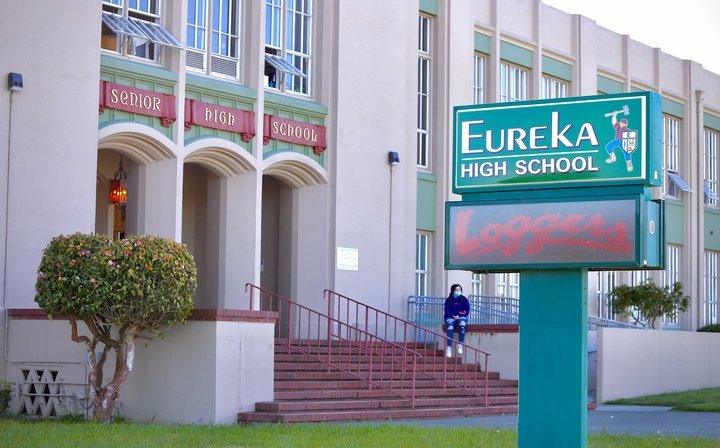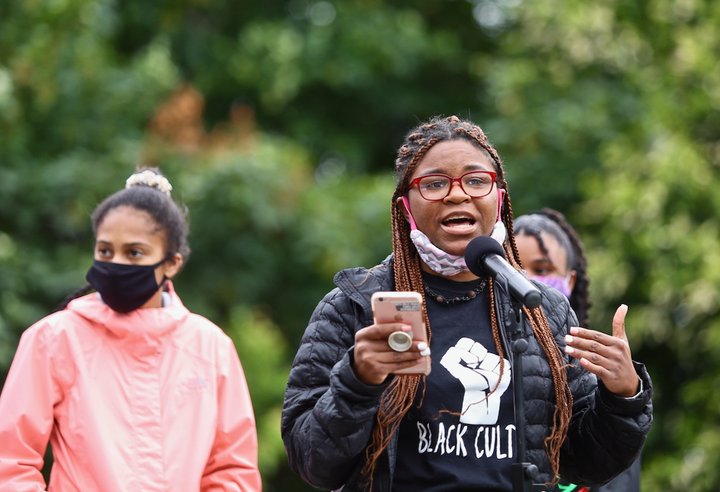
Eureka High School | Outpost file photo: Andrew Goff
###
PREVIOUSLY:
###
The mural will be of David Josiah Lawson and his mother, Charmaine.
“It’s not really to highlight his death, but highlight his legacy that he left behind,” Amaya Watson, president of the Eureka High Black Student Union and Eureka City Schools student board representative, told the Outpost.
“Charmaine has done a lot for Humboldt’s community, especially the Black youth around here.”
The Lawsons will be surrounded by the silhouettes of Martin Luther King, Tupac, Nina Simone, Maya Angelou and others, each holding a fist in the air, each painted in yellow, green or red over a black background.
It will have quotes written above the figures, and a row of seven more fists bordering the bottom. Below the fists will be the names of Black people who have fallen because of injustice.
The mural will have these things, that is, if it ever exists at all.
It depends on whether the Eureka City Schools Board of Education votes to overturn its November decision to ban murals on ECS campuses. Because that vote interrupted a two-years-and-counting mural project aiming to give an artistic platform to Eureka High clubs representing BIPOC students, the ban sorely alarmed ECS students, staff and community members invested in the murals.
The project, led by Naomi Doherty, began with a $2,500 grant from the Humboldt Area Foundation and grew into a community-wide effort after the Eureka NAACP raised $5,000 to pay local BIPOC artists to paint the murals and the project became a DreamMaker Project of the Ink People, renamed A.R.C. (Art. Representation. Culture.). The mural Watson described, designed by the Eureka High Black Student Union, is just one of four murals still in the planning stages by BSU, Asian and Pacific Islander Club, Latinx Club and Native American Club.
As president of the BSU, Watson became very involved with the project. She went to ECS campuses to meet with principals and learn about other murals in the district, and as a student board representative, communicated with the board on behalf of all four clubs. “Nothing was able to get lost or fizzled in translation because I was able to speak at the board meetings and answer any questions anybody had,” Watson said.

Amaya Watson speaking at a Black Lives Matter event in June 2020. | Photo: Andrew Goff
Things were going as planned for the project when the district requested Doherty help develop formal mural guidelines for ECS – a mural-approval procedure that never existed before now. Doherty agreed, but when the board couldn’t agree on the mural guidelines – discussed over two board meetings in October and November – Superintendent Fred Van Vleck recommended the board vote to no longer allow murals. And they did; Trustees Mike Duncan, Fran Taplin and Lisa Ollivier approved of the ban, while Watson and Trustee Mario Fernandez voted “no.” Trustee Susan Johnson was absent.
The community rallied. Sharrone Blanck, Eureka NAACP president, asked community members to contact the board with a request to reopen the discussion. A teacher wrote a letter – that 21 faculty club advisors endorsed – urging the board to reopen discussion. The Black Student Union sent a wave of letters asking for the same thing.
It’s looking like those four murals might find their way onto Eureka High’s buildings after all. At last night’s board meeting, Trustee Susan Johnson, who was absent for the November vote, asked that the board return to the mural procedures item on a future agenda.
“I felt really bad that I missed the board meeting when we had the vote on the mural,” Johnson said. “I feel bad that I wasn’t there and that’s part of my job. And so I’d like to ask that we bring it back.”
The meeting, packed with students and community members in support of the murals, broke into applause with Johson’s request.
During their board reports, Trustees Ollivier and Duncan seemed to indicate that they might change their no-more-murals vote when the item comes back at a future meeting. (To be clear, the item will return as approving or not approving the criteria for murals.) Ollivier, inspired by equity seminars at the recent California School Boards Association Annual Education Conference, said she’s interested in developing an equity policy for ECS.
Public comment came after Johnson’s request, and students, teachers and community members spoke about the importance of the murals.
One student, an immigrant and member of BSU and Latinx clubs, said she felt welcome when she walked into the cafeteria for the first time and saw her country’s flag on the wall. “Having a mural showing my history, where I’m from, my background, it will [make me and more students] feel more welcome.”
Amy Uyeki, a local artist and a member of Humboldt Asians and Pacific Islanders in Solidarity, said it was heartening to hear that the board will reconsider.
“Much of the artwork I do reflects my cultural background. And it often shares history that doesn’t appear in history books, or is not known to the general audiences in our community. Art is the most accessible means of communication on a deeper level,” Uyeki said. “BIPOC students sharing their voices in an expressive way can only have positive repercussions for the entire school and for the community.”
Watson’s parents, Latrice and Ray Watson, both addressed the board.
“I just want to thank you guys for bringing the guidelines back to the agenda for the next meeting. But I also encourage you not just to bring it with a lighthearted discussion, to really have deep conversations about what the students are asking,” Ray Watson said.
“It really hurt me to hear what happened at the last board meeting. It did, because I raised my kids to be leaders, to speak up,” he said.
“Board members should take this opportunity to explore your own bias and what makes you uncomfortable. Your personal opinion may not align with the greater good of the voice of the students,” Latrice Watson said.
“I urge you to reconsider the guidelines for murals for Eureka City Schools and appoint a subcommittee of staff, teachers, students and our community members to do further research on other district policies.”
As NAACP president, Blanck extended an offer to help the district with equity.
“Equity needs to be addressed with the people that are affected,” Blanck said. “Having people of color, adults of color in the space, having people who identify as LGBTQ+ in the space, and other groups that have been marginalized and continue to be marginalized in the space is going to be necessary. A room full of white people talking about equity is not going to lead to anything that’s helpful to the community.”
Today, Watson said she’s trying to stay optimistic about the mural guidelines getting through the board.
“Based on the past meetings, I’m trying to stay grounded and be ready to jump through any hoops that may be thrown at me,” she said. Watson missed last night’s board meeting; she was out of town.
“It sounds like all of the board members across the whole panel were kind of feeling optimistic about murals now that they’re seeing our view and actually hearing that it’s more than just a mural; how much it actually means to the students and the parents and the whole school community.”
CLICK TO MANAGE